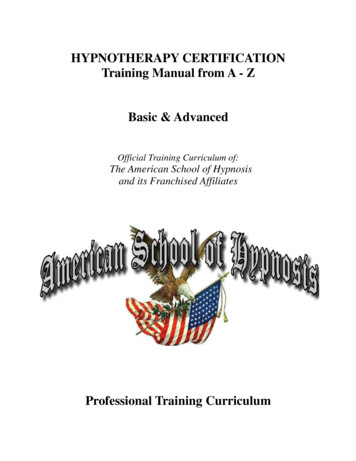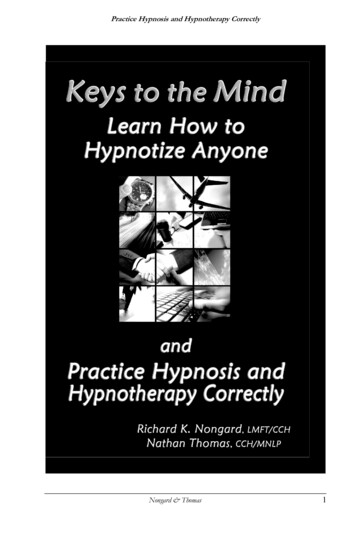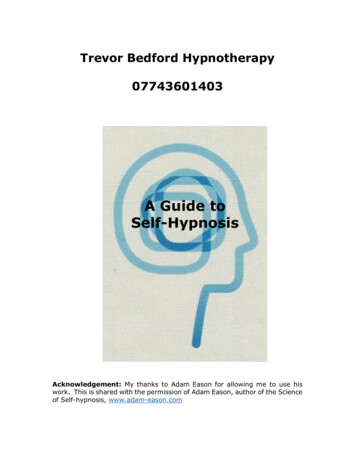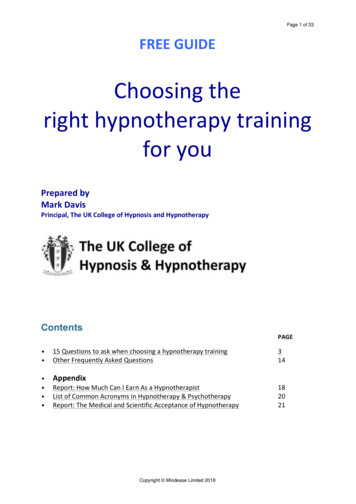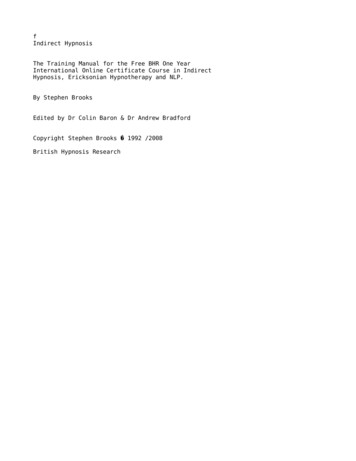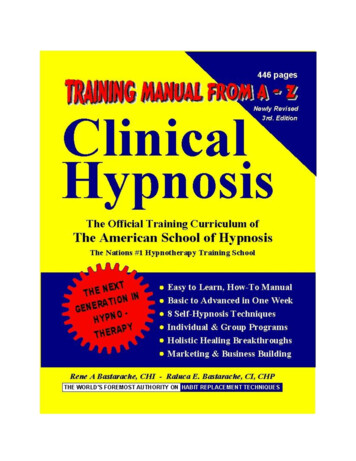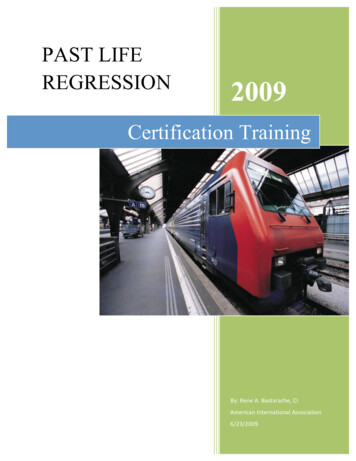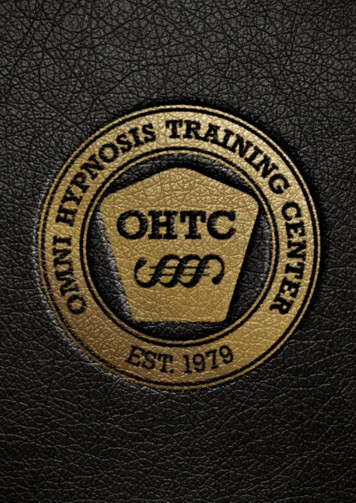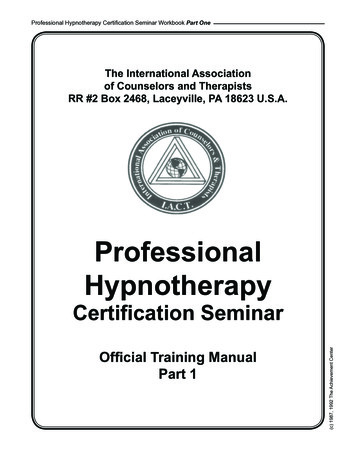
Transcription
Professional Hypnotherapy Certification Seminar Workbook Part OneThe International Associationof Counselors and TherapistsRR #2 Box 2468, Laceyville, PA 18623 U.S.A.ProfessionalHypnotherapyOfficial Training ManualPart 11(c) 1987, 1992 The Achievement CenterCertification Seminar
Professional Hypnotherapy Certification Seminar Workbook Part OneHistorical Overview of HypnosisMisconceptions Regarding HypnosisAdvice for BeginnersOccupation of “Hypnotherapist” DefinedLaws of SuggestionRules of the MindTypes of SuggestionsKeys to Effective SuggestionsPre-Induction Protocol / Suggestibility Testing10-Step “I’m in Control” PresentationSuggestibility TestingPractical HintsForward Sway Suggestibility TestHand ClaspRising and Falling ArmsEyelock TestFinger Spreading Suggestibility TestPendulum MethodEssentials for Successful HypnosisLevels of TranceForms of Hypnotic InductionWays to create a hypnotic inductionVarious Induction MethodsCharacteristics of Experienced SubjectsBien’s Hypnosis Responsiveness QuestionnaireProgressive Relaxation InductionEye Fixation InductionFlower’s Blink MethodDave Elman InductionArm Drawing ConversionArm LevitationSelf-Hypnosis 27282829293031323334353637(c) 1987, 1992 The Achievement CenterTable of Contents (Hypnosis Part 1)
Professional Hypnotherapy Certification Seminar Workbook Part OnePractical Hints for Delivering SuggestionsDynamics of ChangeSubjective Hypnotic DepthTrance RecognitionHypnotic Deepening TechniquesHypnotic Challenges and DeepeningReactional Hypnosis / FractionationHypnotic DevicesTrance RatificationEnding the TranceAbreactionsHypnosis with ChildrenDangers of SmokingSuggestions for the Smoking Cessation ClientSmoking Cessation Hypnotic ProgrammingWeight-Control Hypnotic ProgrammingStress-Management Hypnotic ProgrammingSelf-Confidence Hypnotic ProgrammingMetaphorsAnalogiesAphorismsStructuring a MetaphorFirst Session OutlineFour Stages of Programming the ClientClass Partner Evaluation SheetThe First SessionSession TwoSession ThreeSession Four and Subsequent SessionsIntake and Client Release FormsQuestions and Answers about HypnosisQuestions and Answers about 252535355596162636464657073(c) 1987, 1992 The Achievement CenterTable of Contents (Hypnosis Part 1 Continued)
Professional Hypnotherapy Certification Seminar Workbook Part One(c) 1987, 1992 The Achievement Center“The reward is great that follows the persistent study of hypnotism:for it is a science that bestows upon its devotees a powerthat seems almost superhuman. It overawes everyone whowitnesses its indisputable facts and its marvelous manifestations.It overthrows the theories of judges and philosophers andtheologians, and shakes the faith of material scientists in theirpreconceived opinions. It supplants the physician and the surgeonand cures the afflicted and deformed whom they pronouncedbeyond the hope of recovery. It breaks the chains of demoralizingand destructive habits. It comforts the sorrowing and brings peaceof mind to those distracted by the perplexities of life. It abolishesperiods of time and extents of distance. It causes the lame towalk and strengthens the weak. It checks the hand of death andsnatches almost from the grave the grim destroyer’s victims.It loosens the tongue of the stammerer, overcomes the selfconsciousness of the socially shy and tempers the impetuosity ofthe rash enthusiast. To mankind, in every walk of life, hypnotismis a blessing - leading his innermost thoughts to higher andnobler things: developing his powers to plan and to execute andgiving him social, financial and intellectual eminence among hisfellowmen. All this, and more is Hypnotism.”From the Introduction to Practical Lessons inHypnotism by William Wesley Cook, M.D., 19014
Professional Hypnotherapy Certification Seminar Workbook Part OneHistorical Overview of HypnosisThrough pictographsand other early writingswe can assume thathypnosis was usedbefore recordedhistory. The EbersPapyrus is a 3000year old document thatdescribes how anEgyptian Soothsayerfunctions. What isdescribed are ideasand techniques of hypnosis. Sleep Temples, located in Egypt and Greece, wereholistic healing centers, where various healing techniques, including hypnosis, wereused.The first known cure using hypnosis was by a temple priest. The priest inducedsleep, laid on hands, and cured a conversion disorder (hysterical conversion). GreekOracles used hypnotic techniques in their fortune telling. Hindu Fakirs and Yogisused specialized techniques at that time, yet today we realize that it was hypnosisthat they were using. It is also suspected that the Druids, a very secret cult, alsoused hypnosis.Primitive Societies: Two forms of hypnosis are prevalent - bothassociated with religious experience.1. Rhythmical Repetition2. Frantic DancingFranz Anton Mesmer (1734 - 1815) began in Vienna and latermoved to Paris. He wanted to explain what he was doing ina scientific way. Mesmer borrowed ideas from others.1. Paracelsus, with his idea of magnets.2. Richard Mead, who said that living systems wererun by natural laws.3. Father Hell, a Jesuit Priest, who attempted todiscover ways to cure people with metal plates.These plates were passed across people’s bodies.The idea was that a curative process of HeavenlyBodies would cure people.5(c) 1987, 1992 The Achievement CenterIn the Middle Ages, hypnosis was practiced mostly by Royalty,and was known as the “Royal Touch.” Most notable wereEdward the Confessor (1066) and the Kings of France, whoconsidered themselves divine. The idea died in the late18th century, during the Renaissance, when people startedlooking for a scientific basis for this. It was revived for thecoronation of Charles X, who used the Royal Touch in thecoronation proceedings. One notable person in this periodwas Paracelsus, who felt that Heavenly Bodies fed through a magnet to the humanbody. He said, “A magnet could cure most illnesses.”
Professional Hypnotherapy Certification Seminar Workbook Part OneThe Marquis de Puysegur (1781 - 1825),a follower of Mesmer, while applyingMesmer’s magnetism to a 24 year-oldshepherd, observed hypnotic phenomenaunknown to Mesmer. He noticed that themagnetized subject, instead of showingthe usual “mesmeric convulsions” orunpleasant effects, fell into a peacefulsleep.In this state, the subject was able to openhis eyes, talk in a slurred manner andact as if he were awake. Puysegur calledthis “Artificial Somnambulism.” JosephPhilippe Francois Deleuze (1753 - 1835)discovered that suggestions given to aperson during the hypnotic trance wouldbe carried over into the waking state.6(c) 1987, 1992 The Achievement CenterMesmer also claimed that the Heavenly Bodies cured. From Richard Mead, hegot the idea that in every body there is a universal fluid. When that fluid is runningwell, everything in the body is running well. When the body is not running well, it isbecause the universal fluid is blocked. Mesmer would run metal plates over peopleto unblock the universal fluid (the theory of “Animal Magnetism”).Mesmer’s technique wasto fill a tub with water andiron filings. The personhe was attemptingto cure grabbed ontothe iron bars, until themagnetism wentthrough him/her.Mesmer claimed he hadspecial powers. Hesaid that magnetism wasdrawn to him througha glass wand. He felt thathe could cure anythingthrough magnetism. Hehad a staggering rateof success, became richand powerful, and verytaken up with his ownself-importance. Hedemanded that the FrenchAcademy of Medicinestudy his methods. Acommission in Paris,headed by Ben Franklin,was appointed toinvestigate his claims. Mesmer was discredited in 1784. The findings of thecommission concluded that “Magnetism produces nothing.” Mesmer was run outof town, but not before he ran a real estate scheme that swindled a lot of peopleout of money. He died in poverty in Switzerland.
Professional Hypnotherapy Certification Seminar Workbook Part OneThe first tooth wasextracted usinghypnosis in 1823. Thefirst childbirth was in 1826. PhineasParkhurst Quimby (1859), a clock makerwho became a Mesmerist, trained twopeople who later became famous:1. Rev. H.S. Evans: He came to the U.S.and founded Holistic Churches.2. Mary Baker Eddy: Founded the ChristianScientists. She, however, felt that inhypnosis, the operator was in charge, notGod, so she left hypnosis.By the mid1850’s, a lotof people(doctors,dentists, andothers) wereall usinghypnosis, butas time went on,more professionalpeople droppedaway from using itbecause they werecalled quacks, andlost their licenses.In those days, themain issue was, “Is hypnosis a godlikephenomenon?” This was because in theearly days, hypnosis was entwined with thespiritual.In the 1880’s two diverseschools of hypnosisarose. Charcot was aNeurologist (an earlyterm for psychologist)in France who startedby working with twelvewomen who weresuffering from conversionhysteria. Charcot woulddo flashy demonstrations,showing them regainsight, regain the abilityto walk, etc., while inthe hypnotic state, thenlosing these abilities when brought out ofthe state. Charcot didn’t fully understandhypnosis (he felt it was dangerous, and thatonly the mentally ill could be hypnotized).Bernheim, a famous Paris Neurologist, andLiebeault, a country doctor, formed a clinicin Nancy, France. They treated over 12,000using hypnosis, and introduced the conceptsof suggestibility and sexuality.Freud came to see both Charcot andBernheim. He used hypnosis, but did notunderstand it. He believed that the only wayit could be effective was to achieve a verydeep trance state (which we know today isincorrect). Freud was not a good hypnotist.He thought Charcot was right.7(c) 1987, 1992 The Achievement CenterJames Esdaile (1845) was the Britishdoctor who wrote the book, “Mesmerismin India.” He worked in prison in India andperformed over 3000 operations with noanesthetic. Usually under these conditions,at least 50% will die. He trained lackeys toput a person on a table. The lackey woulddo physical passes over the body for twodays. With this, the mortality rate went downto 5%. (Today, we know the reason for this:in hypnosis, bleeding is minimized. Alsothe body develops resistance to infectionand does not lose bodyfluids). The BritishMedical Associationdecided that Esdailewas a quack, and hewas put on trial. Hewas told that whathe was doing wasblasphemous because“God meant people tosuffer.”
Professional Hypnotherapy Certification Seminar Workbook Part OneMany people have heard or read that Sigmund Freud considered hypnosis to be dangerous.Actually, Sigmund Freud was quoted as saying, “There is no doubt that the field of hypnotictreatment is far more extensive than that of other methods of treating nervous illnesses.” Healso said, “Everything that has been said and written about the great dangers of hypnosisbelongs to the realm of fable.” In addition, Freud also declared that, if psychotherapy wasto be really useful it would have to be used along with hypnosis.Yet, during his later years, he did condemn hypnosis This was due his lack of hypnotizingskill, and the challenges he had with rapport and transference. In one incident he claimedthat a young woman, while in a trance, jumped up and kissed him on the lips (the actualstory is not quite as exciting). What some people don’t know is that Freud controlled painby using cocaine leaves between his cheeks and gums. This eventually destroyed hisgums, causing his dentures not to fit properly. Hence, he could not speak clearly enoughto hypnotize people effectively. As Freud began to develop his system of psychoanalysis,various theoretical considerations, as well as his difficulty in hypnotizing some patients, ledhim to discard hypnosis in favor of free association. Freud’s denouncement of hypnosisgreatly damaged its credibility for many years, especially with the medical community.Hypnotherapy was probably set back 50 years because of Freud’s lack of “hypnotizingability”.In 1960, the American Psychology Associationcreated a board of examiners in hypnosis.Yet, at this writing, no medical school offers acourse in hypnosis. Some dental schools do,and only one university offers an accreditedcourse (Pepperdine, in California).Effectiveness of Hypnosis verses Other ModalitiesTherapeutic Hypnosis is proven to be the most effective and fastest route tosolve emotional issues. American Health Magazine reported the followingfindings from a recent study: Psychoanalysis: 38% recovery after 600 sessions. Behavior Therapy: 72% recovery after 22 sessions. Hypnotherapy: 93% recovery after 6 sessions.8(c) 1987, 1992 The Achievement CenterDuring World War I and World War I I, hypnosis was used for the treatment of shell shock.But other than that, there was no serious use for it. Finally, in 1955, the British MedicalAssociation stated that it was fine to use hypnosis in the treatment of conversion hysteriaor as an anesthetic. In 1958, the American Medical Association made the same statement, but continued to say that they condemned stage hypnotists.The AMA formed committees to find the majordangers. With no findings, the committeeswere disbanded fifteen years later.
Professional Hypnotherapy Certification Seminar Workbook Part OneSome Important Names and Dates in HypnosisFrederick (Frans) Anton Mesmer (1734 - 1815)Theory of Animal MagnetismThe Marquis De Puysegur (1781 - 1825)Discovered the hypnotic state as it is known today.Demonstrated artificial somnambulism instead of hysterical outbursts associated withMesmer.Father Johan Gassner (1729 - 1779)Jesuit priest who used exorcist-like techniques and reported spectacular cures.Jose Custodio de Faria (1755 - 1819)Portuguese priest who discovered that the willingness and cooperation of the subjectwas necessary for the successful production of animal magnetism.Dr. James Braid (1795 - 1860)Considered to be the father of the scientific evolution of
Professional Hypnotherapy Certification Seminar Workbook Part One The International Association of Counselors and Therapists RR #2 Box 2468, Laceyville, PA 18623 U.S.A. Professional Hypnotherapy Certification Seminar Official Training Manual Part 1
